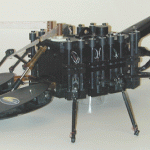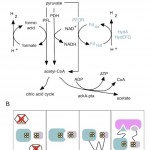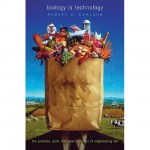engineering
A small selection from some tables of content from a few recent journals and proceedings. These will require subscription access to the ACM Digital Library.
Technical Symposium on Computer Science Education
Connecting k-16 curriculum & policy: making computer science engaging, accessible, and hospitable for underrepresented students by Joanna Goode
Computational thinking for the sciences: a three day workshop for high school science teachers by Sheikh Iqbal Ahamed, Dennis Brylow, et al.
Connecting across campus by Mark D. LeBlanc, Tom Armstrong, Michael B. Gousie
Teaching communication…
Many people in synthetic biology, including myself and much of my lab, are working on using biology to make things more efficiently, renewably, and sustainably. Being able to make plastic replacing biomaterials, chemicals, medicines, and fuels in living cells from renewable resources (especially in photosynthetic organisms that need only sunlight and water) will undoubtedly decrease our dependence on fossil fuels and with a lot of work in policy and process and infrastructure engineering may one day become truly sustainable. It's difficult to not notice, however, how unsustainable most…
I got a lot of interesting responses to my post about DIYbio and how modeling innovation in biotech on computer hacker culture may lead to a science that is less "democratized" than what is being proposed. My friend Adam pointed me to Jaron Lanier's work criticizing the "open" and "free" culture movements online as both unfair and leading to cultural stagnation. While I don't agree with all of Lanier's arguments about the prospects of an open digital culture, he makes a lot of really important points that resonate with my feelings about the future of science based on the open online model, in…
Wednesday was Ada Lovelace Day!
Ada Lovelace Day is an international day of blogging to celebrate the achievements of women in technology and science.
The first Ada Lovelace Day was held on 24th march 2009 and was a huge success. It attracted nearly 2000 signatories to the pledge and 2000 more people who signed up on Facebook. Over 1200 people added their post URL to the Ada Lovelace Day 2009 mash-up. The day itself was covered by BBC News Channel, BBC.co.uk, Radio 5 Live, The Guardian, The Telegraph, The Metro, Computer Weekly, and VNUnet, as well as hundreds of blogs worldwide.
In 2010 Ada…
Synthetic biology deliberately equates genetic networks to electronic circuits, cells to machines, organisms to factories. In synthetic biology, every living can be thought of as a cyborg, a living machine that can be manipulated, changed to meet our needs, parts swapped in and out like a computer. Some projects in synthetic biology and biologically inspired engineering hope to bring the analogy a step further, combining biological and actual electronic and mechanical components into a single engineered unit, with the goal of essentially making tiny autonomous cyborgs.
There are a lot of…
ISTL is a great resource for those of us in science and technology libraries. I'm happy to report on the tables of contents from the last two issues.
Winter 2010
Evaluation of an Audience Response System in Library Orientations for Engineering Students by Denise A. Brush, Rowan University
Open Access Citation Advantage: An Annotated Bibliography by A. Ben Wagner, University at Buffalo
Information Portals: A New Tool for Teaching Information Literacy Skills by Debra Kolah, Rice University and Michael Fosmire, Purdue University
Are Article Influence Scores Comparable across Scientific…
My paper, "Insulation of a synthetic hydrogen metabolism circuit in bacteria" just came out in the Journal of Biological Engineering! And it's open access!
We designed a metabolic circuit in bacteria that produces hydrogen (a potentially useful fuel) from natural precursors in the cell. The proteins in our synthetic pathway work to make hydrogen by transferring high-energy electrons from pyruvate, a common metabolite, to protons that are freely floating in the watery cytoplasm. The electrons transfer between the proteins through quantum-mechanical tunneling, which makes hydrogenases and…
The inaugural Canadian Engineering Education Association Conference will be held this year from June 7-9 at Queen's University in Kingston, Ontario.
The Canadian Engineering Education Association (CEEA) is a new organization whose mission is to "enhance the competence and relevance of graduates from Canadian Engineering schools through continuous improvement in engineering education and design education." This first annual CEEA conference will integrate and grow on the previous efforts of the Canadian Design Engineering Network (CDEN) and the Canadian Congress on Engineering Education (C2E2…
Queen's University engineering librarian Michael White runs The Patent Librarian's Notebook, a very important resource for anyone interested in finding and making sense of patent information.
He's done a very comprehensive review of the important 2009 developments in public patent databases and related websites.
An example:
Canadian Patents Database (CIPO)
The Canadian Patents Database, which is maintained by the Canadian Intellectual Property Office, contains more than two million Canadian patents and published applications from 1869 to the present. Full-text images are available from 1920…
"The history of any given technology is extraordinarily complex."
--Rob Carlson, Biology is Technology.
Analyzing the history of a technology requires a complex look at the social, economic, and political context in which it emerged, and the reciprocal influences that the developing technology exerts on these factors. Predicting what the future of a technology will be like, how it will affect the economy and understanding the potential risks and payoffs is much much harder. Rob Carlson's new book, Biology is Technology: The Promise, Peril, and New Business of…
tags: NASA, Endeavour, International Space Station, spaceship launch, STS-130,Kennedy Space Center, space exploration, physics, astronomy, engineering, streaming video
Space shuttle Endeavour, carrying Commander George Zamka, pilot Terry Virts, and Mission Specialists Nicholas Patrick, Bob Behnken, Steve Robinson and Kay Hire, successfully launched from the Kennedy Space Center in the early hours of February 8, headed for its 13-day STS-130 mission to the International Space Station.
Riversimple, a small UK-based company, has designed a tiny, relatively cheap, and remarkably open-source hydrogen fuel cell car. The car will not be available for sale, but people will be able to lease it, with the lease agreement including maintenance, fuel, and the eventual recycling of the car. This unique business model allows for the company to manage sustainability for the life of the car. Check out the video below to see the car in action:
Hydrogen, of course is still hard to make, and there aren't many sustainable hydrogen production options. My lab is working on ways to make…
tags: How it's Made: Snowboards, snowboards, sports, engineering, material science, technology, streaming video
This video describes in detail something that winter sports enthusiasts care about during this time of year!
During my winter blogging break, I thought I'd repost of few of my "greatest hits" from my old blog, just so you all wouldn't miss me so much. This one is from September 24, 2007. It's my initial thoughts about the blog I've been using to post my IL session notes.
It's worth noting that the blog has evolved such that it's hardly about or for engineering or computer science students at all; it's more for the sessions I do for "science for non-science students" courses. Also, the use of Meebo has been a huge hit for me, really creating a new way for me to interact with students.
I'll be re-…
A selection of articles from two recent IEEE publications which have special issues devoted to humanitarian service in engineering. Note that most of these articles will be behind the IEEE paywall.
IEEE Transactions on Professional Communication, v52i4.
The Role of Information and Communication in the Context of Humanitarian Service by Haselkorn, M; Walton, R
Adapting to Change: Becoming a Learning Organization as a Relief and Development Agency by Smith, S.; Young, A.
Listening as a Missing Dimension in Engineering Education: Implications for Sustainable Community Development Efforts by…
"Amaryllis," by Katelyn Sack
I work in the engineering school here at U.Va. My office faces a lobby-type area just outside the main computer lab for undergrads. That space has blank walls. We recently commandeered it and opened up an art gallery. The painting above is one of four currently hanging in this first installment. I make note of the exhibit here, at The World's Fair, because it seems entirely in keeping with the ethos of this blog, where in our best days we cross the so-called boundaries between scientific, artistic, and political worlds.
from KS collection
U.Va.'s…
The September Communications of the ACM has a provocative article by Peter J. Denning and Paul S. Rosenbloom, Computing: the fourth great domain of science (OA version). It's well written and persuasive, certainly worth reading the whole thing.
Science has a long-standing tradition of grouping fields into three categories: the physical, life, and social sciences. The physical sciences focus on physical phenomena, especially materials, energy, electromagnetism, gravity, motion, and quantum effects. The life sciences focus on living things, especially species, metabolism, reproduction, and…
I've always thought the born-digital, high-quality review articles (called "lectures") that Morgan & Claypool publish as part of their Synthesis product are one of the best products out there. They really get publishing scholarly and professional materials in the digital age.
One of their most interesting lecture series is the Synthesis Lectures on Engineers, Technology and Society.
Three new lectures in that series look to be perfect texts for a broad range of Engineering & Society-type course. In fact, I think a pretty good course along those lines could use nothing but the…
Just yesterday I posted on preserving the the history of the computing field, musing at the end that digitization projects could save a lot of documents.
Well, what comes along today in the latest What's New @ IEEE for Students is a note about the IEEE-USA History Project:
Digital Archives, Organization's Four Decades of Service Unveiled
IEEE-USA is building a digital archive featuring documents and photos of its 36-year history of promoting the careers and public policy interests of U.S. IEEE members. Part of the IEEE-USA History Project, the archive features:
An overview of the first four…
Eugenie Samuel Reich is a reporter whose work in the Boston Globe, Nature, and New Scientist will be well-known to those with an interest in scientific conduct (and misconduct). In Plastic Fantastic: How the Biggest Fraud in Physics Shook the Scientific World, she turns her skills as an investigative reporter to writing a book-length exploration of Jan Hendrik Schön's frauds at Bell Labs, providing a detailed picture of the conditions that made it possible for him to get away with his fraud as long as he did.
Eugenie Samuel Reich agreed to answer some questions about Plastic Fantastic and…



